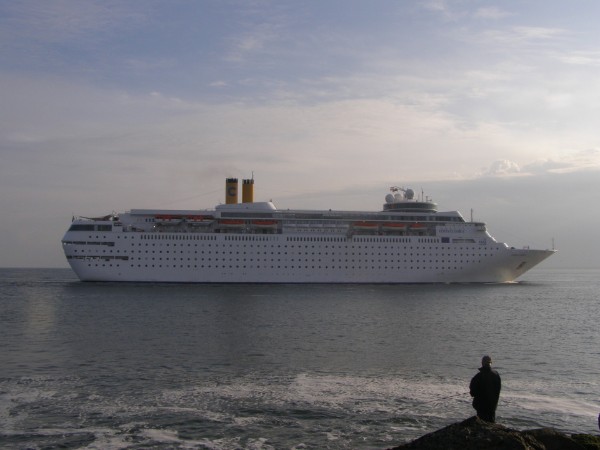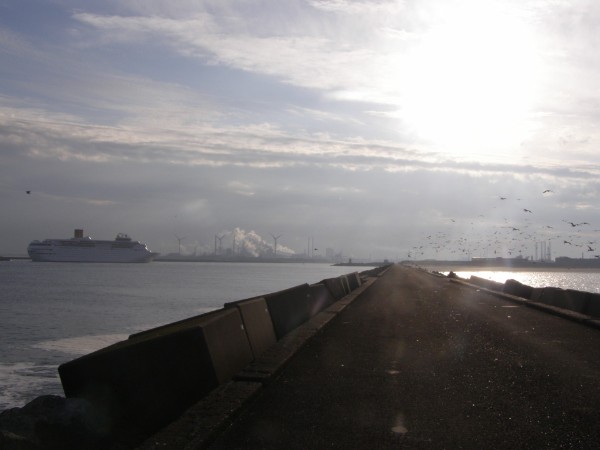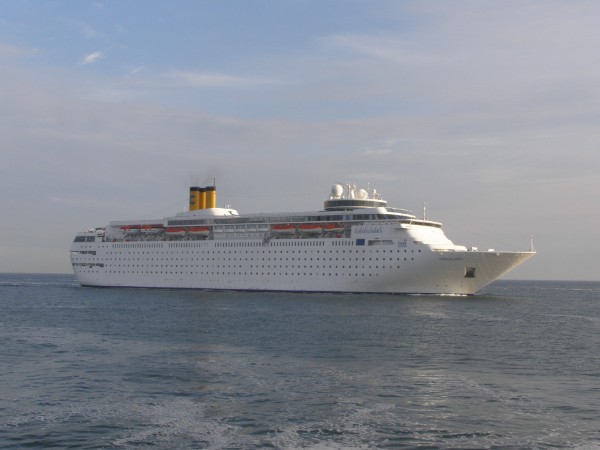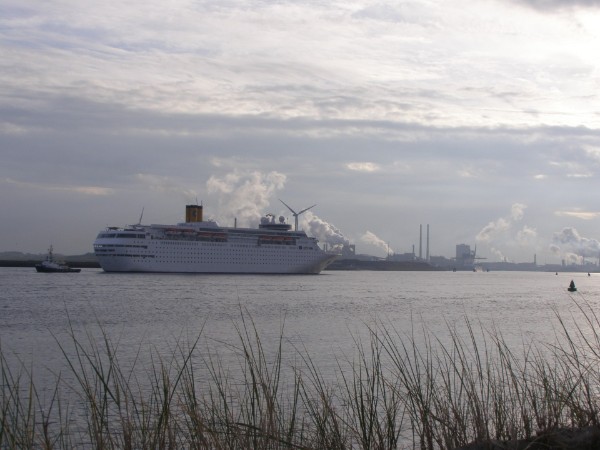Costa Classica

Above, Costa Classica is seen entering the outer harbour of IJmuiden at the 23rd of may in 2014 for a visit to The Netherlands.
At the end of the 1980's, Costa Crociere introduced the Euroluxe concept for its two soon to be introduced cruiseliners. The line was at that moment mostly sailing with older former oceanliners that were in service under the names of members from the Costa family of Genoa, Italy, as it had always been a family-owned company. In shipnames, Costa had broken tradition earlier with Costa Riviera between 1985 and 1993, the former Guglielmo Marconi, but for the new Euroluxe ships, the names were also going to begin with the Costa-prefix. Next to these ships, Costa also bought two former containervessels that were rebuilt under the names of Costa Marina and Costa Allegra. Although those had been built in the 1960's, they were totally stripped, rebuilt and modernized, emerging as stylish 30.000-ton cruiseliners in the beginning of the 1990's. In total, Costa invested around 900 million dollars, of which half was reserved for the new ships. Next to the fleet extensions, also the older ships were refreshed, especially the Enrico C and Eugenio C. When the total investment was done, Costa became the fifth largest cruise-operator in the world, doubling capacity since 1989.
Costa Classica was the first ship of the new Euroluxe twins and she left her building dock at the Fincantieri Cantieri Navali Italiani yards of Monfalcone at the 2nd of february 1991. She had been built under yardnumber 5877 and originally was going to sail under the Italian flag with her homeport Genoa. The ship measured 52.926 tons and had a lenght of 222,61 meters. Costa Classica was 32,78 meters wide and had a draft of 7,60 meters. Her normal sailing speed is around 20,2 knots. On her ten passengerdecks, the ship had cabins for 1766 passengers and 590 crewmembers.

Her trials were sailed in june 1991 after a ceremonial naming by Emilia Costa at the 7th of june in Venice. She was delivered to Costa Cruises at the 7th of december of that same year as the largest ship that had ever been sailing for the old Italian line. The ship was designed for the American market, although she had to have a European style, hence the name Euroluxe. This also meant that the company was slightly going to loose their Italian image and replace it with a more genuine European image. The company really wanted to position itself in the upper market, but this did not work out as planned. This is one of the reasons why the old family-owned line was bought by Carnival Cruise Lines in 1996, together with the British-based Airtours. Under Carnival ownership, the company started to become more and more the European counterpart of the mothercompany, mostly their new ships were built in classes together with the Carnival ones, designed for the mass-market. Costa Classica and her later sister Costa Romantica were designed by Gregotti Associati with many classic touches, combined with modern needs. The funnels were especially recognizable, consisting out of three combined yellow stacks. This concept was used in all new Costa ships, including the re-built containerships, throughout the beginning of the 1990's and became a line's trademark. Also, Costa Classica and Costa Romantica recieved a disco above the bridge-area with views of 180 degrees, a little like the Royal Caribbean ships with their viking-crowns. Her interiours, as being designed by only one architect, really form one distinct style throughout the ship, mostly by the use of marble, reds and greens. She was traditionally designed, with the cabins at the lower decks. Newer ships do have all cabins higher up, so they can have the luxury of a private balcony. On the newer ships, the public rooms are located lower down the hull.
At the 17th of december 1991, Costa Classica left Genoa for her first official cruise in the Mediterranean. The following winter, she left for Miami to sail a series of 7-day cruises in the Caribbean, before going back to the Med in the following summer. This is the normal sailing scedule for Costa ships and this has been so ever since she was introduced.

Between 1994 and the year 2000, Costa Classica had her homeport changed to Monrovia and she started to fly the Liberian flag, but this was altered again to Genoa since the start of the new millennium. It was also planned to have the ship lenghtened and awarded with an extra deck in that same year, so she headed for the Cammel Laird wharf at Birkenhead in England for a total refreshment and rebuilding where she was expected at the 23rd of november 2000. The ship was to get a new midsection of 44,8 meters and also she was going to have an extra deck. This was going to be one of the largest rebuildings ever in cruise-history and it would award her also with balcony cabins, something she really started to miss. In the extra midsection, there was going to be a piano bar, an Internet-café, a teen area, two extra lounges and 352 new passengercabins as well as 132 crewcabins. Also her powerplant was to be extended so she could sail at a somewhat higher speed. During the waryears in the former Yugoslavia, it was clear that she was too slow to make it from Venice to Greece in the expected time so she had to be faster too. Expected was that she would reach 23 knots after the rebuilding was finished. But when the ship was already close to La Coruna, Spain while sailing for Liverpool, she was ordered back due to an unexpected delay at the wharf. Because Costa and Cammel Laird couldn't reach an agreement, the whole operation was cancelled and this also meant the end of the wharf, as it was declared bankrupt soon afterwards. Because of the cancellation, technicians from Costa that were already at the wharf, had to be escorted out under surveillance of the security officials from Cammell Laird. The wharf had hoped for new orders so passengerships again could be built in Britain because of the Costa-assignment, but now this was also off the table. Just before the cancellation, Cammell Laird reported that they had won the contracts for two passengerships for Luxus that were to be 28.000 tonners. If it had gone through, those would be the first cruiseliners built in Britain since 25 years. This all is the reason that Costa Classica still has her original lines up untill now. The new midsection, that was already completed, was towed to Rotterdam and later scrapped.

Several events interrupted the otherwise smooth cruiseservice of the ship. At the 19th of july 1997, she ran aground at Kythira in Greece, but the ship wasn't damaged too much and after hull-inspection, the cruise did go ahead as sceduled. Something more then ten years later, at the 8th of june 2008, she 'kissed' the MSC Poesia near Dubrovnik in Croatia, after the anchorline of the MSC ship had failed and the ship drifted towards the Costa liner. Again, damage to both was minimal. In 2010, she again collided with another ship, this time a Belgian freighter while she was sailing a cruise in the Far East. Costa Classica suffered a gash in her hull above the waterline of about 60 feet and three passengers had to be taken ashore for medical treatment. After repairs in Changxing, that took up about 96 hours, the ship was again ready to sail on her next cruise from Hong Kong.

The last picture shows the ship almost docked at the Felison Cruise terminal in IJmuiden at the 23rd of may 2014.
At the end of 2014, Costa Classica re-emerged as Costa neoClassica for the Costa NeoCollection. This is a new concept within the fleet of Costa Cruises, where mostly the line's smaller and older ships are rebuilt and offer more quiet time and personal service for the passengers. The ship lost the large casino and theater and recieved several smaller entertainment venues aboard. Also, passengers can really customise their cruise to their own specific needs, concerning dining options or shore excursions and even the onboard entertainment. From january 11th, 2015, the rebuild ship started sailing Indian Ocean cruises from Mauritius, together with the recently aquired Grand Mistral, that was renamed Costa neoRiviera for the Neo Collection.
In the end of 2017, Costa NeoClassica left the Costa fleet as she was sold to Bahamas Paradise Cruise Line to become their second ship Grand Classica. Bahamas Paradise Cruise Line operates a two-night service between Florida and the Grand Bahama Island using the former Carnival Cruise Lines ship Celebration under the name of Grand Celebration. The first cruise for the Grand Classica started at the 13th of april 2018, departing Palm Beach, Florida for Grand Bahama Island.

